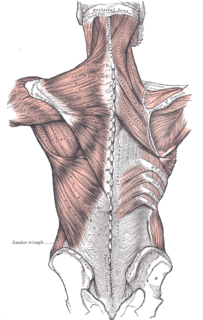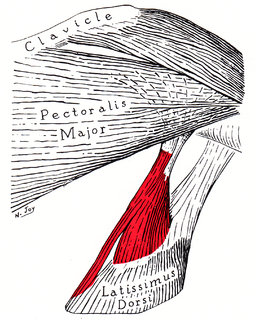Thoracodorsal may refer to:
| This disambiguation page lists articles associated with the title Thoracodorsal. If an internal link led you here, you may wish to change the link to point directly to the intended article. |
Thoracodorsal may refer to:
| This disambiguation page lists articles associated with the title Thoracodorsal. If an internal link led you here, you may wish to change the link to point directly to the intended article. |

The nipple is a raised region of tissue on the surface of the breast from which, in females, milk leaves the breast through the lactiferous ducts to feed an infant. The milk can flow through the nipple passively or it can be ejected by smooth muscle contractions that occur along the ductal system. The nipple is surrounded by the areola, which is often a darker color than the surrounding skin. It is often called a teat when referring to non-humans. Teat can also be used to describe the flexible mouthpiece of a baby bottle. In humans, nipples of both males and females can be stimulated as part of sexual arousal. In many cultures, human female nipples are sexualized, or "...regarded as sex objects and evaluated in terms of their physical characteristics and sexiness."

The latissimus dorsi is a large, flat muscle on the back that stretches to the sides, behind the arm, and is partly covered by the trapezius on the back near the midline. The word latissimus dorsi comes from Latin and means "broadest [muscle] of the back", from "latissimus" ' and "dorsum". The pair of muscles are commonly known as "lats", especially among bodybuilders. The latissimus dorsi is the largest muscle in the upper body.

The brachial plexus is a network of nerves formed by the ventral rami of the lower four cervical nerves and first thoracic nerve. This plexus extends from the spinal cord, through the cervicoaxillary canal in the neck, over the first rib, and into the armpit. It supplies afferent and efferent nerve fibers to the chest, shoulder, arm and hand.

The dorsal scapular nerve arises from the brachial plexus, usually from the plexus root of the cervical nerve C5. Once the nerve leaves C5 it commonly pierces the middle scalene muscle, and continues deep to levator scapulae and the rhomboids.
Phalloplasty is the construction or reconstruction of a penis, or the artificial modification of the penis by surgery. The term phalloplasty is also occasionally used to refer to penis enlargement.

Hidradenitis suppurativa (HS), also known as acne inversa, is a long term skin disease characterized by the occurrence of inflamed and swollen lumps. These are typically painful and break open releasing fluid or pus. The areas most commonly affected are the underarms, under the breasts, and groin. Scar tissue remains after healing. Self-consciousness or depression may result.

The upper limb or upper extremity is the region in a vertebrate animal extending from the deltoid region up to and including the hand, including the arm, axilla and shoulder.

The teres major muscle is a muscle of the upper limb. It attaches to the scapula and the humerus and is one of the seven scapulohumeral muscles. It is a thick but somewhat flattened muscle.

The thoracodorsal nerve is a nerve present in humans and other animals, also known as the middle subscapular nerve or the long subscapular nerve. It supplies the latissimus dorsi muscle.

The subscapular artery, the largest branch of the axillary artery, arises from the third part of the axillary artery at the lower border of the subscapularis muscle, which it follows to the inferior angle of the scapula, where it anastomoses with the lateral thoracic and intercostal arteries, and with the descending branch of the dorsal scapular artery, and ends in the neighboring muscles.

Dog anatomy comprises the anatomical studies of the visible parts of the body of a canine. Details of structures vary tremendously from breed to breed, more than in any other animal species, wild or domesticated, as dogs are highly variable in height and weight. The smallest known adult dog was a Yorkshire Terrier that stood only 6.3 cm (2.5 in) at the shoulder, 9.5 cm (3.7 in) in length along the head and body, and weighed only 113 grams (4.0 oz). The largest known adult dog was an English Mastiff which weighed 155.6 kg (343 lb) and was 250 cm (98 in) from the snout to the tail. The tallest known adult dog is a Great Dane that stands 106.7 cm (42.0 in) at the shoulder.

The thoracolumbar fascia is a deep investing membrane throughout most of the posterior thorax and abdomen although it is a thin fibrous lamina in the thoracic region. Above, it is continuous with a similar investing layer on the back of the neck—the nuchal fascia.

Subscapular nerves can refer to:

The thoracodorsal artery is a branch of the subscapular artery. It travels inferiorly with the thoracodorsal nerve and supplies the latissimus dorsi.

The following outline is provided as an overview of and topical guide to human anatomy:

The cervical spinal nerve 8 (C8) is a spinal nerve of the cervical segment.

The following outline is provided as an overview of and topical guide to the human nervous system:

The axillary arch is a variant of the latissimus dorsi muscle in humans. It is found as a slip of muscle or fascia extending between the latissimus dorsi muscle and the pectoralis major. There is considerable variation in the exact position of its origin and insertions as well as its blood and nerve supply. Its presence in different ethnic groups varies, being present in about 7% of Europeans and with higher rates in the Chinese and less common in the Turkish population. The arch may occur on one or both sides of the body.